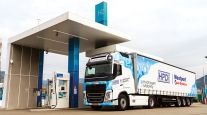Nat Gas May Trigger Shift in Intermodal, Analyst Says
This story appears in the June 2 print edition of Transport Topics.
Lower-priced natural gas used for fueling trucks could alter the current intermodal market and shift some freight back to truckload service, a consultant said.
“Natural gas has the potential to change the competitive equation,” said Jason Kuehn, vice president of surface transportation with consultant Oliver Wyman.
He said it could narrow the rails’ competitive advantage in fast-growing Eastern freight markets.
Kuehn said during a May 23 conference call that lower-priced natural gas could make truck shipments more economical than intermodal over distances of as much as 750 miles, potentially boosting truck freight volumes.
By comparison, the 50% higher fuel cost of diesel-powered trucks currently makes intermodal more economical than trucks over trips of as little as 550 miles.
Increasing the intermodal “break-even” distance to 750 miles from 550 miles would have a “dramatic impact” on the relative competitive position of intermodal and truckload service, said Kuehn, who previously worked for three railroads.
Kuehn also said that the possible shift in the competitive balance triggered by natural-gas conversion primarily would target the eastern United States.
That’s because shipment distances of 500 to 1,000 miles predominate in the eastern United States, connecting places such as Chicago and New York, or Atlanta and Washington.
The region also has been the fastest-growing area for intermodal over the past four years. Norfolk Southern and CSX have increased intermodal loads by 7% and 6%, respectively, in that period, outpacing Western rails BNSF and Union Pacific.
Kuehn estimated that natural gas could reduce trucking costs by 15% for shipments of all distances.
While the “break-even” distance may change, Kuehn also said trucking factors such as the driver shortage and regulatory constraints will continue to boost intermodal freight.
“We think trucks will go after that advantage pretty quickly,” Kuehn said, noting that investment in natural gas-powered units has a payback period of three to five years.
Truck-fueling infrastructure represents the primary hurdle to long-distance trucking via natural-gas power, he said, predicting that barrier will be gone in as little as two years.
“The trucking industry may have a leg up on the railroads when it comes to converting over to natural-gas engines,” said a report from John Larkin, an analyst at Stifel, Nicolaus & Co., which hosted the conference call.
“For the traffic that is price sensitive, some shift in market share could take place back to the trucks,” Larkin told Transport Topics, noting that can only happen if truckers aggressively shift to natural gas and can find drivers.
“Fuel is one of several variables that contributes to transportation costs and modal selection and can’t be considered in a vacuum or as a stand-alone,” said Joni Casey, president of the Intermodal Association of North America. She cited other factors such as driver turnover and shortages and highway congestion.
By comparison, Kuehn believes railroads will be slower to embrace natural gas, waiting until 2017 to possibly begin a conversion that could take five years.
“Natural-gas locomotives are in their infancy,” he said, citing several reasons. One of them is the difference between locomotives and tractors.
Railroad locomotives typically last 30 years or more — five times longer than trucks — which makes rail executives more cautious than truckers about changing fuel sources until benefits are proven.
BNSF, CSX and Canadian National Railway all have done or plan to do natural gas-powered locomotive tests, but there is no longhaul natural-gas locomotive in production, Kuehn said.
Regulation provides another barrier.
Liquefied natural gas locomotives would require a “tender” car to carry LNG to be placed next to the locomotives to provide fuel. However, Kuehn noted that federal regulations now require freight cars carrying LNG to be placed six cars behind the locomotive to limit exposure if an LNG load explodes.
But he also said that future intermodal growth also could be limited by rail capacity in spite of substantial recent investments. Among those he cited was CSX’s $175 million outlay on an Ohio intermodal hub.
Truck/rail loads set a record last year and are on pace to top 2013, based on Association of American Railroads statistics. Intermodal now accounts for more than 40% of rail shipments and will continue to grow faster than gross domestic product, Kuehn said.
To keep pace with intermodal growth, he said, at least two new major intermodal terminals will have to be built annually.
Over the past several years, he noted, new terminals have been opened primarily in the eastern United States by Norfolk Southern and CSX to accommodate growth. Last week, Union Pacific Railroad opened a $400 million facility in New Mexico, near the Mexican border.




